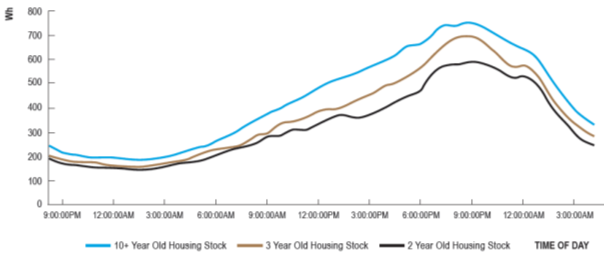Housing regulations driving down energy demand
Data hiding within obscure energy regulatory documents reveals that housing energy efficiency regulations have succeeded in reducing household energy demand.
The Housing Industry Association fought tooth and nail to stop regulations ultimately introduced in 2006 to upgrade the thermal energy efficiency of newly built Australian homes. They were also heavily criticised by the Productivity Commission in a 2005 report, which questioned their likely effectiveness.
Yet our charts of the week, using data from Victorian Energy Utility SP Ausnet, suggests they have indeed been successful in reducing energy demand, at least for Victoria.
Amongst the several hundred pages of SP Ausnet’s regulatory price submission to the Australian Energy Regulator, it reveals that average household gas consumption is 6 per cent lower in 2010 relative to 2003 normalising for the effects of weather (gas usage is higher when weather is colder).
Part of the reason comes down to the introduction of the five star housing energy efficiency regulations. The chart below taken from the demand forecast report, illustrates gas usage for houses and units/apartments built in each of the years from 2003 to 2009 relative to houses built prior to 2003. Gas consumption in dwellings built in 2003, 2004 and 2005 has been greater than that of the older housing stock. Then for homes built from 2006 onwards, when 5-star became mandatory, there is a dramatic drop in gas consumption.
Gas usage of dwellings built in 2003 to 2009 relative to pre-2003 dwelling stock

Source: Centre for International Economics (2012) Gas demand forecasting SPAusNet, 2013-17
According to the Centre for International Economics, which prepared SP Ausnet’s gas demand forecasts,
In 2006, there is a significant downward step in gas use from new dwellings. This likely reflects the adoption of 5-star energy efficiency standards. A dwelling built in 2006 uses about 12.4 per cent less gas than one built in 2005
What is really interesting is that it appears that electricity consumption, not just gas, is also lower in newly built homes within SP Ausnet’s electricity distribution area (which covers a different region to their gas network), as illustrated in the chart below. This is in spite of newer homes tending to be larger than the building stock built more than 10 years ago.
Electricity consumption profile for housing stock of different ages in SP Ausnet distribution area

Source: SP Ausnet data cited in AEMC (2013) Strategic Priorities for Energy Market Development
SP Ausnet’s electricity distribution network services a rural-regional area of Victoria east of Melbourne where a number of towns lack access to natural gas. So they may be more reliant on electricity for heating purposes than the rest of Victoria.
This would explain why 5-star (now upgraded to a 6 star standard) has managed to noticeably reduce electricity consumption in their network. However one should also recognise that energy reductions across this region would extend beyond electricity because a number of homes serviced by SP Ausnet’s electricity network have access to natural gas and some would use wood or LP Gas for heating. For homes that are reliant on electricity alone for heating, the demand reductions from the 5 and now 6 star regulatory standards are likely to be noticeably greater than illustrated in the chart above.
In light of this information if the NSW and Queensland Governments were really as concerned for household energy bills as their rhetoric suggests, they'd match the national 6 star standard. NSW is still to catch-up with 5 star via their BASIX regulations, while Queensland recently pulled 6 star requirements for multi-unit dwellings.
















